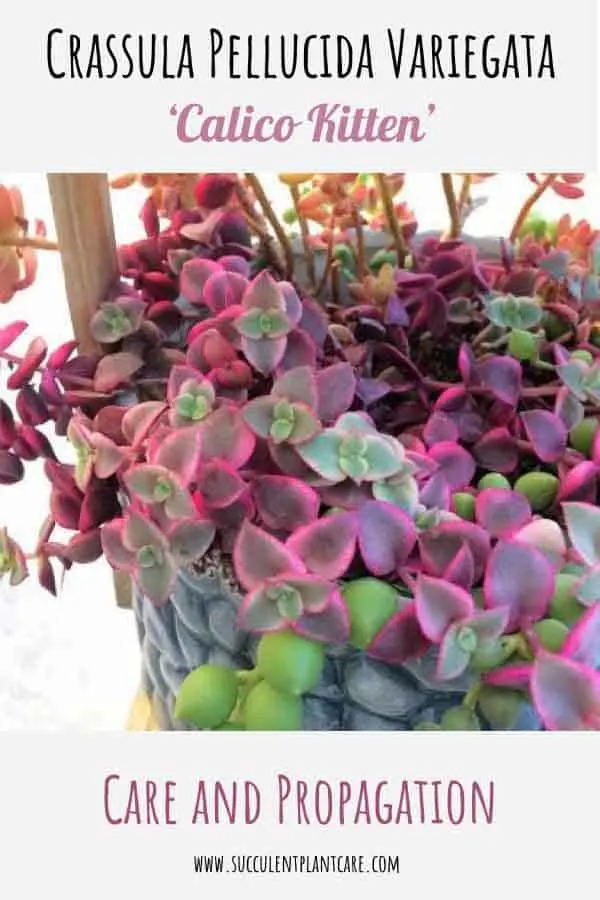Have you ever been struck by something so beautiful that you wanted to cry? That’s how I feel about Crassula Pellucida Variegata ‘Calico Kitten’.
Yes, I know I’m weird, but there’s no shame in it. I love my plants and this plant tops the list. Crassula Pellucida ‘Variegata’ (Calico Kitten) aka Crassula Marginalis Rubra ‘Variegata’ is a gorgeous looking plant with heart-shaped variegated leaves.
The leaves are a combination of different shades of green; from pale green to yellow-green, and different shades of pinks and creams. The leaves can take on hues of fuschia and purple and can turn a deep purple color when the plant is very dry. The plant trails and looks great in hanging baskets or really tall planters. They produce cheerful little white flowers.
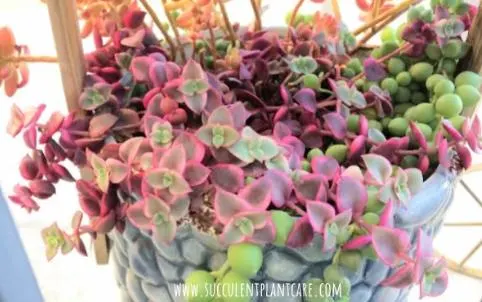
Native to South Africa, Crassula Pellucida ‘Variegata’ (Calico Kitten) is such a beautiful plant the pictures I have do not do it justice. Perhaps I should learn to take better pictures because I really cannot get a good enough picture of this plant to capture all its intricate details, colors and beauty.
Care for this plant can be tricky in the beginning, but they harden with time and with proper care. Slow growers at first, they can be vigorous growers once they get going. They are low growing plants and tend to spread out or spill over the sides of the pot instead of growing tall.
Crassula Pellucida ‘Variegata’ (Calico Kitten) Care
Indoor Lighting Requirements
Crassula Pellucida ‘Variegata’ (Calico Kitten) can be grown both indoors and out. Place in a bright location indoors, anywhere where there is plenty of light. Try an east facing window. A south and west facing window may also work but you may need to move the plant around a few times to find the best spot.
Some windows may get too hot during the summer months or from the more intense afternoon heat. Watch your plant and see how it reacts, then move as needed. If it is getting scorched, provide shade or move to a different location. If the plant starts to suffer from lack of light, move to a brighter location. To keep them really happy, they need approximately 5-6 hours of bright light per day.
These plants cannot tolerate low light or poor lighting for prolonged periods of time. If your indoor space does not receive adequate lighting no matter the time of the day, you may consider using a grow light. Grow lights can help supplement your plants’ lighting requirements especially during those long, dark winters. Here are some of my grow light recommendations.
To read more about this topic on indoor lighting for succulents, check out my post on “Proper Lighting for Succulents Indoors” to get some helpful tips.
Outdoor Sunlight Requirements
Partial to Full Sun. Crassula Pellucida ‘Variegata’ (Calico Kitten) do best in areas that receive plenty of bright, partial sunlight. They can also tolerate full sun but needs to be acclimated to full sun to prevent burning the plant.
Before moving the plant outdoors or increasing the amount of sunlight it receives, it is better to acclimate the plant by gradually increasing the amount of sunlight it receives until it is fully acclimated to the intense sun. You can start with providing morning light which is less intense than the afternoon heat. Keep in mind that even when the plant is already acclimated to full sun, it can still get sunburned during a heatwave or intense heat.
Sunshades are a real lifesaver for my plants during the intense summer heat here in Northern California where the temperatures can rise above 100℉ or 37.8℃. Here are some of my recommendations for sunshades and sun protection.
For further details and information on outdoor sunlight requirements, please visit my post “How Much Sunlight Do Succulents Need Outdoors?” to get some useful tidbits.

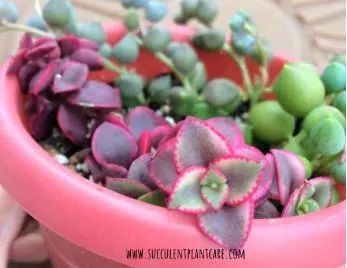
Crassula Pellucida ‘Variegata’ (Calico Kitten) up close
Frost Tolerance
Crassula Pellucida ‘Variegata’ (Calico Kitten) are hardiest in USDA hardiness zones 9-11. It can tolerate mild frost and slightly freezing temperatures as long as they are not for long periods of time. If you live in USDA hardiness zones 9-11, you can get away with leaving the plant outdoors all year long. I have kept mine outdoors all year long, and they survive the freezing rain and frost we experience in winter time mainly because of all the bright sun we receive during the day.
For those people in areas with extreme winter conditions, the best way to grow these plants is in containers. That way you can bring them indoors during winter or when there is a forecast of frost or snow. In case you can’t bring your plants in, there are ways to protect them from frost and freezing temperatures outdoors. You can use frost cloths or mini greenhouses to help them survive the cold winter. Here are some of my recommendations for frost protection.
For further tips on this topic, check out my post on “Optimal Temperatures For Succulents to Survive and Thrive”.
Soil Requirements
Like any other succulent plant, Crassula Pellucida ‘Variegata’ (Calico Kitten) needs a well-draining soil. The right type of soil goes hand in hand with proper watering. I have been using a simple, tried and tested mixture that has worked well for my plants. I like to use a cactus potting mix combined with perlite for added drainage. I do not use exact measurements but eyeball it to about 2:1 solution of cactus mix and perlite. Others recommend using sandy soil. This can be achieved by mixing cactus mix or potting soil with coarse sand (about 2:1 ratio). Or you can use a combination of the three materials mentioned (1:1:1). I get most of my materials from a local hardware store. You can also purchase them online. Here are my soil recommendations. To read more about soil for succulents, click on “Best Soil and Fertilizer for Succulents” to get more useful information.
Watering Requirements
Watering largely depends on the climate you live in. Although these plants are highly adapted to dry weather conditions, they do much better when given sufficient amounts of water. There really isn’t a set schedule or formula on when to water succulents. My watering schedule is dictated by the very dry climate I am in. We hear about overwatering a lot, and these plants are no exception. Overwatering is detrimental to these plants and can cause root rot.
In the summer months, I water my Crassula Pellucida ‘Variegata’ (Calico Kitten) as often as every 7-10 days. I cut back on watering to about every 10-14 days when the weather cools down. During the winter season, I mostly rely on rainwater and hold back on watering altogether because this is when we get a lot of rain in my area. But if we don’t get any rain at all during winter then I water at least once a month or every 2-3 weeks, depending on how dry the soil gets.
For those people in humid locations, you won’t need to water as much. And if you keep your plants indoors, you may not have to water as much especially if they are not receiving a lot of light. Too much water and not enough light is a recipe for disaster for these plants. I often hear of folks watering their succulents indoors once a week and they wonder why their plants are dying from the root up. If you keep your plants indoors, they most likely do not need to be watered all that much. And I am speaking from a very dry climate perspective. If you live in a humid area, you do not need to water that often or stick to a set watering schedule.
One good way to tell whether it’s time to water is to check the moisture of the soil. The top inch of the soil needs to feel dry before you can water again. If you are unsure how much and how often to water in the beginning, it’s always better to underwater and increase watering as needed. Pay attention to how your plant looks and you can adjust watering accordingly.
For further help with watering techniques, consider using tools like hygrometers or moisture meters to check for moisture in the soil and air. These tools are pretty affordable and can come in handy especially if you are unsure of when to water your plant next. I have narrowed down the choices here on my resource page. Do visit the page if you need help in gauging your watering needs.
Need to find out more about watering succulents? Visit my post “How And When To Water Succulents” where I go into more details about this topic.
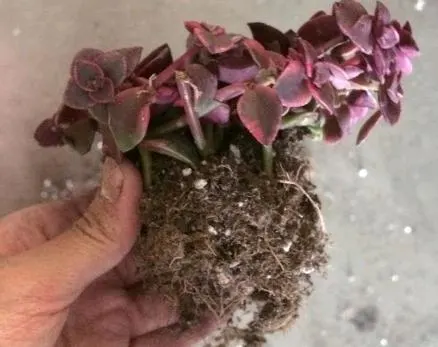
Repotting a Crassula Pellucida ‘Variegata’ (Calico Kitten)
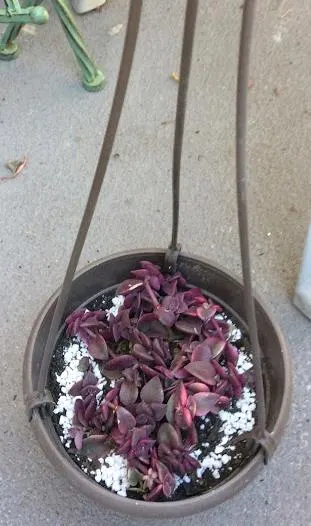
Propagating Crassula Pellucida ‘Variegata’ (Calico Kitten)
The easiest and quickest way to propagate these plants is through stem cuttings. They can be propagated from leaves, but I find the process trickier and less foolproof than using stem cuttings. Propagating from leaves with this type of plant takes time and patience, but it is definitely doable. If you want to try to give leaf propagation a try, make sure to use the entire leaf including the base to ensure success. I have a much higher success rate with stem cuttings so I always opt for this method first. The only time I propagate from leaves with this plant is if an entire leaf has broken off.
Propagating from Stem Cuttings:
- Obtain a stem cutting and let it dry for a day or so. Since the stems are thin they shouldn’t take that long to dry. It is also a good idea to obtain cuttings from healthy looking plants with plump leaves, not dehydrated ones or stressed plants.
- (Optional) Dip the cut end in rooting hormone. I usually skip this step but some people prefer using rooting hormones to speed up the process and also guarantee success.
- Once the cut has healed and dried, stick the cuttings in a well draining potting mix.
- Keep away from direct sunlight. Water the soil every few days or when it feels dry.
- After about two weeks or so, you will notice new roots growing.
- After about four to six weeks, the cuttings should be fully rooted and you will soon notice new growth developing from the top or the sides of the stem.
- Once fully rooted, cut back on the misting and switch to regular watering about once a week or less. Increase the amount of sunlight as the plant matures.
Propagating From Leaves
- Gently pull a leaf out, make sure you get the entire leaf including the base. You should be able to gently twist the leaf off the plant and it should come off easily. Try to find a nice plump leaf that looks healthy. It also helps to have more than one leaf just because not all of them will make it all the way to the end.
- Optional: Dip the cut ends in rooting hormone. Rooting hormone can help speed the propagation process up, especially when growing from leaves.
- Wait for the leaves to dry for about a day or two. Keep in a dry location away from direct sunlight.
- Prepare a well draining potting mix. Once dry, lay the leaves flat on the soil or stick the cut ends in soil.
- The leaves should start shooting out roots in about 2 weeks or so. In a few more weeks you will notice a new baby plant emerging. The whole process can take anywhere from a few weeks to months.
As I mentioned above, it will obviously take longer to propagate from single leaves as opposed to an entire stem. Success rate is also higher with stem cuttings so do keep these in mind when propagating. If you follow these simple steps, you will be able to propagate these plants and have them growing everywhere in no time.
These are stems that have broken off after a windy stormy night. I am propagated them by sticking the ends in soil. Crassula Pellucida ‘Variegata’ (Calico Kitten) and Senecio Rowleyanus (String of Pearls) plants:
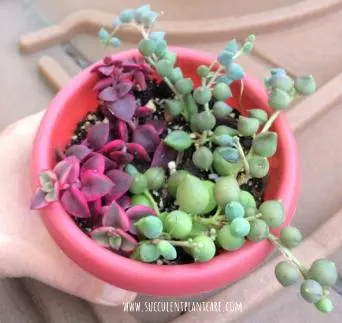
Common Problems with Growing Crassula Pellucida ‘Variegata’ (Calico Kitten)
Brown Leaves
The most common cause of brown leaves is sunburn. These plants do best under partial sunlight. Simply move the plant to a shadier location to prevent sunburn. Sunburn spots on the leaves are permanent but does not really hurt the plant internally, as long as the problem is corrected. You can trim the brown, sunburnt spots off or wait for new growth to develop.
Mushy Brown Leaves
The most common reason for mushy brown leaves is overwatering. The plant will look unwell and the leaves will get soft and mushy and appear translucent. These are telltale signs that you are overwatering your plant. Cut back on watering and allow the plant to dry out and recover from too much water. Do not water until the plant has had a chance to dry out completely. If the soil is not drying out fast enough, consider switching to a fast draining one. Root rot can develop when left in wet soil. Once you notice rot, you can still save the plant by cutting off the dead parts of the plant. Save anything that looks viable to propagate and repot.
Shriveled Leaves
The most common reason for shriveled leaves is underwatering. The leaves will feel flat and deflated. These plants store water in their stems and leaves. Once their water storage runs out, you will notice the plant looking shriveled. The leaves will appear thin, dried up and shriveled. Simply water the plant thoroughly and it should perk right up within a day or two.
Remember, it is easier to ‘fix’ an underwatered plant than an overwatered one so when in doubt, err on the side of caution when watering especially if you are not familiar with the plant.
Aphids or Mealybugs
Aphids and mealybugs are common pests that affect succulent plants. These pests particularly love tender succulents such as Crassula Pellucida ‘Variegata’ (Calico Kitten) and like to suck on the sap on the plant. These insects are easy to miss because they are so tiny and they often hide under the plant or on the undersides of the plant. Once you notice them you might already have a bad infestation. To get rid of them, you need to spray them off your plant. You can use 70% isopropyl alcohol in a spray bottle and spray it all over the infested plant making sure to get all the little nooks and crannies. You can also dilute the alcohol with water if you’re afraid of burning your plant. Keep away from direct sunlight after spraying.
Quick Tip: Busy ants crawling around your pot or anywhere near your plant is usually a sign that you have an aphid or mealybug infestation, or even both. Ants love the sugary substance these pests produce and will gladly protect these pests in exchange for sugar. Get rid of the ants and you can get rid of the pests, and vice versa.
For more on this topic, I have a quick guide to tell you how to get rid of “Common Pests on Succulents”. I have also written an extensive post on a particularly bad aphid and mealybug infestation, which you can find here “How To Treat For Ants, Aphids and Mealybugs”.
Crassula Pellucida ‘Variegata’ (Calico Kitten) Blooms
Crassula Pellucida ‘Variegata’ (Calico Kitten) produce small white flowers that can appear around springtime. It’s always a treat to see my succulents bloom. Keep in mind that not all plants are ready to flower, and some may not bloom at all. A lot of it depends on environmental factors beyond our control. To encourage blooms, make sure they are receiving adequate lighting. Along with proper lighting, make sure the plant is kept happy and receiving the proper care as mentioned above.
While fertilizing is not necessary, giving your plants the nutrients they need will help ensure proper growth and encourage blooms. It takes a lot of energy for plants to produce flowers, and feeding them extra nutrients will help supplement their needs during the flowering season. The best time to fertilize is during the active growing season, or during spring and summer months. A balanced blend of fertilizer for houseplants or a fertilizer specially formulated for cacti and succulents are suitable. Fertilizers are better applied at a quarter or half strength, about every two weeks. Here are some of my fertilizer recommendations.
Along with the right environmental conditions, they also need to go through a wintering period to encourage blooms. This can be achieved by keeping them cool and dry in the winter months, with temperatures just above freezing between 35-44⁰F (1.5-7⁰C).
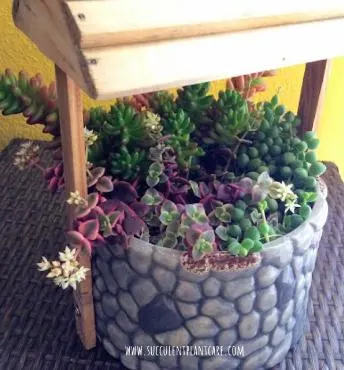
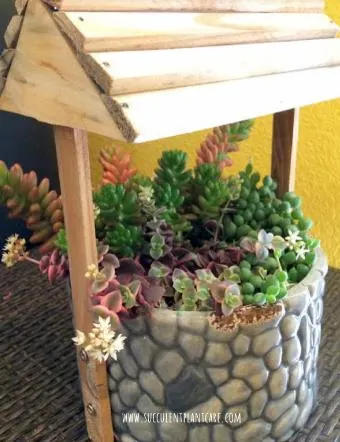
I love all my plants, but Crassula Pellucida ‘Variegata’ (Calico Kitten) has really captured my heart from the very first moment I got it. We can say it was really love at first sight. If you don’t believe me, go check them out and find out for yourself why I can’t stop gushing about these beauties. They are a bit finicky in the beginning which adds to their charm, but they become easy going once you figure them out.
Where can you find a Crassula Pellucida Variegata ‘Calico Kitten’? Check out my resource page for recommendations on where to purchase these and other succulents online.
Pin this post to save for yourself or share with your friends!
